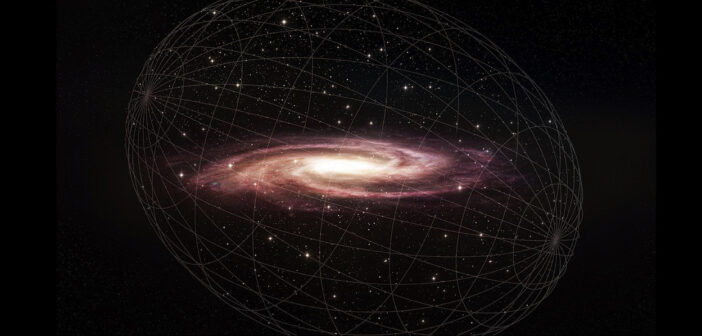Galaxies are embedded within halos of dark matter, the invisible matter thought to make up 85% of the mass of our universe. New research investigates how a tilt in a galaxy’s dark matter halo can affect its stellar halo and stellar disk.
Nestled in a Halo of Dark Matter

Illustration of the components of the Milky Way’s halo. [NASA, ESA, and and A. Feild (STScI)]
While the goings-on in our galaxy’s dark matter halo might seem far removed from life in the thin stellar disk, research by Jiwon Jesse Han (Center for Astrophysics | Harvard & Smithsonian) and collaborators has explored the connection between the two. In a recent article, Han’s team examined the alignment between galaxies’ stellar disks and the inner regions of their dark matter halos and probed what it might mean if the two are misaligned.
Tilting Halos with Ancient Mergers
Using the TNG50 cosmological simulation — part of the IllustrisTNG suite of cosmological simulations — Han’s team selected synthetic galaxies that are similar to the Milky Way and our neighboring galaxy, Andromeda. The simulated galaxies have masses similar to the Milky Way’s present-day mass, a disk-like appearance, and don’t have any other massive galaxies within 500 kiloparsecs (1.6 million light-years).

Dark halo tilt angle versus stellar halo tilt angle, derived from Milky Way–like galaxies in the TNG50 simulation. The measured Milky Way stellar halo tilt is marked with the pink shaded area. The plot to the right shows the most likely tilt angle for the Milky Way’s dark halo. Click to enlarge. [Han et al. 2023]
The Milky Way’s stellar halo is currently tilted relative to its stellar disk at an angle of about 20–30 degrees. Given the parallel behavior of dark halos and stellar halos, this implies that the Milky Way’s inner dark halo is tilted relative to its stellar disk at about 20 degrees. What effect does a tilted dark halo have?
Warped Disks and the Milky Way

Dark halo tilt angle and disk warp amplitude as a function of time for a simulated Milky Way–like galaxy. [Han et al. 2023]
The effects of the tilted dark matter halo were felt in the thin stellar disk, as well: a few billion years post merger, a warp appeared in the previously flat disk. This warp lessened slightly over time but persisted until the present day in the simulation.
Like the simulated galaxy studied here, the Milky Way experienced a merger billions of years ago and today sports a warped disk. Based on the results of the simulation, Han’s team proposed that halo-tilting mergers induce the long-lasting warps in galactic disks seen in more than half of all spiral galaxies today.
Citation
“Tilted Dark Halos Are Common and Long-Lived, and Can Warp Galactic Disks,” Jiwon Jesse Han et al 2023 ApJL 957 L24. doi:10.3847/2041-8213/ad0641
